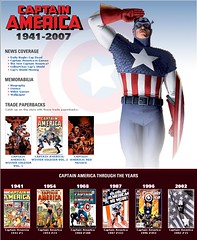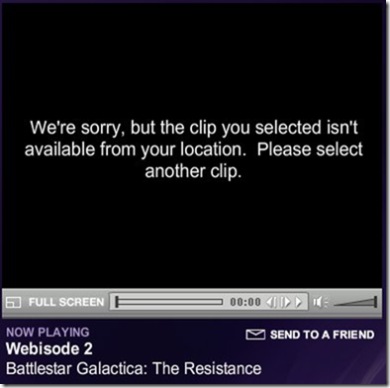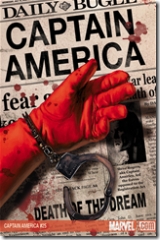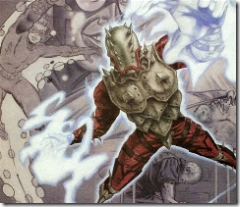Home » fan culture (Page 5)
Category Archives: fan culture
The 4400 Goes Viral (Marketing)
The 4400 has taken to viral marketing dramatically in order to build the word before the upcoming fourth season of the TV show. According to AdWeek:
To promote the new season of The 4400 on USA Network, Campfire has created a wide-ranging interactive world consisting of 80 videos that run from 30 seconds to five minutes and six Web sites. […] The 4400 follows 4,400 people who are abducted, taken away and then returned to planet Earth. After their return, many of them discover they have superpowers. As the fourth season begins on June 17, the plot follows the development of a drug called Promicin: it gives the users superpowers, if it doesn’t kill them. Three different factions emerge around the drug: pro, anti- and neutral.
On YouTube, for example, one of the show’s stars, Billy Campbell, appears in character as Jordan Collier, advocating Promicin and the decrying the government’s attempts to ban the drug. Here’s Jordan Collier dispatch #3:
Elsewhere on the net, we can find the Promicin Power website, which argues that Promicin is the key to world peace and a sustainable relationship with nature. Here’s one example that looks like it could be have been a United Colours of Bennetton advertisement in a past life:
At the other extreme, there’s also Promicin Terror which sees the drug as the biggest threat to the US since Al Qaeda. Clearly building on the famous ‘Daisy‘ political ad of the 60s (which was recycled in the US debates about the War with Iraq), this is an example of a clip campaigning to ban the drug:
I quite enjoyed the last season of The 4400 and am heartened to see the show’s producers so actively embracing the potential of video-sharing and online word-of-mouth. The clips are a little over-produced, but given the state of a lot of TV advertising today, I’m sure they could easily be mistaken for the ‘real thing’.
Mary-Jane Watson … Likes to Wash Peter’s Spider-suit?!?
Marvel’s statues folk have really out-done themselves with these uber-sexist models of Mary-Jane:
As one would rightly imagine, there is considerable disappointment and outrage about this image. While comic books have never exact been modest in their representation of women (or men), this particular statue is ridiculously misogynistic and patronising, even by the standards of early comic books, let alone the twenty-first century. Nor, sadly, is this a unique case, evinced by more examples in ArcanaJ’s “Comics Industry Bullsh*t” Flickr set.
While such an image is clearly sexist, whatever the context, it’s doubly disappointing to see Mary-Jane, who has always been at least a strong, active figure in the comic books, reduced to the sexed-up laundry lady. The latest film, I guess, really doesn’t do much to argue with such a representation – there were moments, there, but MJ was a sadly under-developed character in Spider-Man 3. However, given the huge number of people, and especially kids, looking to find their heroes in comic-books and the films they inspire, this, and similarly images, really need to scrubbed out.
In a different way, Nancy Lorenz replies even more forcefully (and graphically) by showing how ridiculous Spider-Man would look in this pose!
[Via Falling Apart In Half Time]
Update (18 May, 9.45am): Boing Boing links to a post by artist Tom Hodges, a friend of Adam Hughes (who designed the MJ statue). Hodges post includes these comments:
Now I may be wrong, but ANYONE who complains about this piece obvious does NOT read Superhero comics. If you did, I’d consider you a hypocrite. I enjoy the Indie stuff (SiP and Lenore) but without Spider-man, X-Men and other comics, they wouldn’t exist. Do you think Terry Moore is offended by this piece? I HIGHLY doubt it!
That’s probably a fair point; most indie comics came into being on the back of the success of the superheroes comics (and funnies) in establishing comic books as a recognisable form of entertainment and (although more controversially, even today) art. Also, I think Hodges is right in that this statue is not an outlier, but rather representative of a large part of the way Marvel, DC, and many independent comic books, represent women and men. I did read superhero comics a fair bit when I was younger and occasionally pick up stuff at the moment (I enjoyed parts of Marvel’s Civil War and have been consistently impressed by the current Justice mini-series by Alex Ross et al). That said, I think that what this statue represents is the worst aspects of this tradition; I don’t think Adam Hughes should bare the blame for the conventions of much of the art in the superhero genre, but I do think his representation lacked subtlety enough to crystallize the sexist nature of many comic books, even today.
Hodges also suggests this statue may be ironic – pointing out that Mary-Jane in the comics is a far more successful supermodel. Even if that was the intention, I fear it’ll be lost on the majority of people who purchased the statue.
“We’re sorry, but the clip you selected isn’t available from your location:” Watching Battlestar Galactica in Australia and the Tyranny of Digital Distance
I just submitted an abstract for the Media International Australia special issue ‘Beyond Broadcasting: TV for the Twenty-first Century’. Here it is:
“We’re sorry, but the clip you selected isn’t available from your location:” Watching Battlestar Galactica in Australia and the Tyranny of Digital Distance
[Figure 1. Screen-capture from http://www.scifi.com/battlestar/, 11 September 2006]
In the late 1960s, conservative Australian historian Geoffrey Blainey coined the term “the tyranny of distance” to describe how the geographic gap between Australia and the centres of the Western world (US, UK) played a fundamental role is shaping the Australian psyche and character (Geoffrey Blainey, The Tyranny of Distance, Sun Books: Melbourne, 1966). Thirty something years later and the world is far more widely considered a global village; the world wide web, email and a million other applications have made real-time information-heavy communication and commerce the norm. However, while information transfers have made ‘distance’ much less of a concern in a number of ways, many policies, practices and systems of commerce still operate as though they are centred on goods moving at the speed of physical shipping, not allowing for information moving at the speed of light down a copper or optical wire. In an era when ‘the tyranny of distance’ means so much less in many contexts, this paper will argue that in the multimedia markets of contemporary society there is, rather, a prevailing tyranny of digital distance which marks out those areas of communication and commerce in which the potential and, indeed, expectation of synchronous global culture (at least for English-speaking countries) leads to constant state of confusion and annoyance – on both personal and legal levels – when those expectations are not met.
The North American-produced television series Battlestar Galactica, re-imagined for the twenty-first century (from an original 1970s series), has consistently been at the cutting edge of television and cross-media. Executive producer Ronald D. Moore and the Battlestar team utilise not just blogs and production-side video-blogs, but also create episodic commentary podcasts, make deleted scenes available online, and have even put two full episodes online for free for viewing. Likewise, Battlestar was one of the first shows available via Apple’s online iTunes Store. Given the amount of extra online content, and the show’s science fiction genre, Battlestar has a large and very active fan community who consume both the television show itself and the officially produced extra material, as well as actively creating and discussing their own derivative ‘fannish’ works ranging from blog commentaries to fan-created videos. Thus, when the show’s producers launched a series of 3 to 4 minutes ‘webisodes’ to re-build interest in the show prior to the launch of its third season, fans across the (wired) globe were understandably excited. However, when citizens of Australia, the UK, Canada or any other country outside the US tried to view these webisodes, they were met with a notice saying: “We’re sorry, but the clip you selected isn’t available from your location.” The owners of Battlestar (NBC) elected to restrict these webisodes to residents of the US only. This decision upset fans across the global Battlestar audience, with US fans quickly circumventing the restrictions and passing copies of the webisodes to their international fellows. In this paper, I will contend that this moment typifies the tyranny of digital distance, exemplifying the legal, ethical and practical issues raised when a globally-promoted television series ‘centres’ on a single national audience. I outline the difficulties of ‘watching’ Battlestar from Australia, and argue for distribution modes which are more in keeping with the technological (and fan-led) potential of digital distribution.
As you might imagine, this paper will draw together my previous thinking about the tyranny of digital distance which you can read about here and here. I’m also finishing off another Battlestar-related paper that stopped being written for a year, but is now being finished off for a new collection. It’s going to be a busy month, but I’m hopeful both of these will be well polished before Emily and I get married on June 9th (presuming this abstract is accepted). Wish me luck!
Update (8 May 2007): The abstract has been accepted! Thankfully, though, full papers aren’t needed until August 1st so I’ll be writing this after Emily and I return from our honeymoon (in Venice!!) :).
Update 2 (21 September 2007): The full version of this paper has been accepted after peer review, and will appear in Media International Australia issue 126, which is scheduled to be released in February 2008.
Update 3 (26 March, 2008): You final version of this paper has appeared, and you can read it following the link from this post.
A Hard Day’s Night of the Living Dead
John, Paul, George, Ringo … and a world full of Zombies! If you thought it’d never happen, then you were wrong, because wonderous world of video mashups can bring two classics together to make A Hard Day’s Night of the Living Dead …
It’s the best Beatles clip since the Grey Video and some of the smoothest mashups since the Brokeback Mountain inspired series early last year.
When Captain America Drops His Mighty Shield
“It’s a hell of a time for him to go. We really need him now.”
– Joe Simon (co-creator of Captain America)
While Peter Parker and his alter-ego Spider-Man have long been the iconic representation of the layperson (or everyperson) — the ordinary guy who, by accident rather than intent, became a hero — Captain America, in contrast, has always been stood for the ideals of the American dream and the democratic system at its heart. Captain America was created in the midst of World War II, and has fought the Nazis, communism and many other threats to the ‘American way of life’. Given his role, the demise of such a figure is more than a ploy to sell comic books (although it is that, too); it’s a commentary on the upheaval at the heart of what being American actually means. As Joe Simon, Cap’s co-creator along with Jack Kirby, has stated in interviews on the back of Cap’s death: “It’s a hell of a time for him to go. We really need him now.”
In July last year I wrote about the parallels between Marvel’s Civil War storyline and the ‘War of Terror’, noting that the Civil War stories borrowed heavily both from September 11 and the related special-edition tributes done by various comic book publishers. The image of Captain America’s sorrow was used powerfully both in Marvel’s renderings of the ruins of the World Trade Centre Towers and the tragedy which kick-started Marvel’s Civil War. During the past months, I was also impressed by the directness with which the Civil War stories appeared to address the situation in Guantanamo Bay when one of Marvel’s more jovial characters, Speedball – or Robert Baldwin – was arrested as an “an unregistered combatant” and locked away in a prison which seemed to exist outside of legal jurisdiction. To some extent that critique continues beyond the conclusion of the Civil War storyline as Robert Baldwin has now backed down and accepted Registration and become a new ‘hero’ (in the broadest sense of the word) under the guise ‘Penance’, a self-hating hero, wracked by guilt about the deaths his team unwittingly caused, and whose powers emerge proportionally to the amount of pain he’s in (it’s hardly a shock, then, that Warren Ellis is penning Thunderbolts, which now features Penance in the team’s line-up).
[Image from Marvel’s Civil War: Frontline #10; click to enlarge.]
 After those impressive beginnings, I was completely stunned at how badly the Marvel wrapped up its Civil War run, with Cap seemingly surrendering on a revelation — that the war between heroes was hurting a lot of innocent people in its wake — so mundane it bordered on stupid. That said, when Cap was actually gunned down by an assassin in Captain America #25, I could see where the story was supposed to have gone (I still think, though, that his death should have occurred in the last issue of the Civil War story, not another tie-in edition, even Cap’s own book). Cap’s death has altered the Marvel Universe, with even Tony Stark (Iron Man) privately admitting that the Civil War wasn’t worth the death of one of Marvel’s greatest icons (in Civil War: The Confession, yet another Civil war spin-off). There has been a lot of press about Marvel killing off one its core characters, but I think these stories are best summed up by Damian Fowler writing in The Guardian‘s books blogs with these insightful thoughts on ‘Why Captain America had to die’:
After those impressive beginnings, I was completely stunned at how badly the Marvel wrapped up its Civil War run, with Cap seemingly surrendering on a revelation — that the war between heroes was hurting a lot of innocent people in its wake — so mundane it bordered on stupid. That said, when Cap was actually gunned down by an assassin in Captain America #25, I could see where the story was supposed to have gone (I still think, though, that his death should have occurred in the last issue of the Civil War story, not another tie-in edition, even Cap’s own book). Cap’s death has altered the Marvel Universe, with even Tony Stark (Iron Man) privately admitting that the Civil War wasn’t worth the death of one of Marvel’s greatest icons (in Civil War: The Confession, yet another Civil war spin-off). There has been a lot of press about Marvel killing off one its core characters, but I think these stories are best summed up by Damian Fowler writing in The Guardian‘s books blogs with these insightful thoughts on ‘Why Captain America had to die’:
Created by Marvel comics in 1941 to battle the Nazis, the massively-pumped “Cap” was first seen punching Hitler in the face. Nice work if you can get it. But last week the patriotic crusader was shot and killed by a sniper in the latest issue of the long-running comic book.
Over the years, Captain America’s storyline has always reflected American moods and attitudes. When he first showed up, he was a sentinel of liberty and the fight for right. He was a mirror of everything that America stood for during the second world war. He always fought relentlessly for values that the US held dear.
How times change. Now he’s very much dead, something that was confirmed by the president and publisher of Marvel Entertainment. The New York Times all but wrote an obituary for the man, albeit in the arts pages, dead at 66. But it’s a sign of the times.
His demise is so much more than a tragedy in Toontown, even as the comic-book geeks mourn his passing. […] Cap’s death is being seen, analysed and discussed through the prism of national politics as a damning indictment of George Bush’s America. Even the major American TV networks picked up on the story, cutting images of the war in Iraq with the comic book images.
The Marvel Universe post-Captain America is an unfamiliar place. It’s a Marvel Universe in tune with the US and the Western world more broadly; a West which invaded Iraq four years ago but has to bring any semblance of stability to the region. With Cap’s shield gathering dust, his ideological opposite, Iron Man (a weapons manufacturer and alcoholic as well as a superhero) is now in charge of Marvel’s registered super-hero fighting machine (with a team in every state of the US). Spider-man, who revealed his identity during the Civil War, is now part of a small but notable underground resistance, but is also desperately trying to deal with the death of family members. Captain America’s death hangs over the comic book world, and leaves lasting questions about the direction and politics of the world of Marvel and its heroes.
However, As Benari Poulten reminds us, Captain America has been dead before and Steve Rogers has been replaced as Cap in the past, so it’s unlikely that the iconic hero will be gone from the Marvel universe for good. That said, Marvel have enjoyed amazing press and attention in the wake of the assassination of one of their key heroes — Cap’s demise even made ‘the Word’ on The Colbert Report and Steven Colbert now has Cap’s shield in his trophy case — so if death is to carry any weight at all in mainstream comic books, the inevitable return will have to be handled carefully, not just commercially. Personally, I think Steve Rogers should stay dead now, I think his death was representative of many things, including changes in Marvel both as a comic book universe and as part of a multi-national company. That said, words by Peter David about the X-Men titles are increasingly true about all comic book characters: “Mutant heaven has no pearly gates, only revolving doors” (X-Factor #70). If he can’t stay dead, Marvel, please earn any return of Captain America or one of your most striking characters will be diluted beyond a meaningful existence.
(Yes, the title of this post is a shameless adaptation of the Cap cartoon theme song; it’s also an homage to Henry Jenkins’ brilliant essay ‘Captain America Sheds His Might Tears: Comics and September 11’ which appeared in Daniel J. Sherman and Terry Nardin (eds), Terror, Culture, Politics: Rethinking 9/11, Indiana UP, 2006.)
Battlestar Galactica Videomaker Toolkit
As part of their ever-expanding interaction with the fan community, the producers of Battlestar Galactica have announced a competition allowing fans access to selected BSG clips, sounds and music which they can mix with their own footage to create new videos. As their instructions explain:
Be a part of Battlestar Galactica!
We’re giving you sound and visual effects and music clips that you can use to create and share your own four-minute Battlestar videos.
Create your own mock commercials, short scenes or even mini-episodes — funny or dramatic. Choose from more than 30 visual effects, 20-plus audio effects and cuts from the show’s soundtrack, specially selected to help give your videos the Battlestar look and sound. Use them to make your video, add the required promo clip at the end, and send it to us!
Battlestar Galactica executive producer David Eick will choose one video to broadcast in full on SCI FI Channel during an upcoming Battlestar episode.
This sounds fantastic off the bat. Certainly I’d love to have a play and try out my sorely under-used editing skills. However, the instructions also come with these rules:
Your video can’t be longer than four minutes. Don’t use footage you don’t create yourself or that you didn’t get from the Battlestar Videomaker Toolkit.
Do not use any music for which you don’t have the rights.
Do not include images, photos, logos or artwork that you did not create or to which you don’t hold the rights (such as pictures from magazines, books and other Web sites).No inappropriate content. If we can’t show it on network TV in prime time, don’t put it in your video.
Do not post your film on other sites, such as YouTube, MySpace, Google, etc.
You must be a legal resident of the United States and over the age of 18.
So, once again, the Battlestar Galactica franchise is treated as a purely US property. While I sympathise with the demands and difficulties of copyright, I have to concur with the forums in my disappointment that these wonderful fan-engaging opportunities are not open to the wider, global BSG community. This is another instance of what I have called the tyrrany of digital distance.
Also problematic is the notion that these videos can’t be uploaded elsewhere – be it YouTube, MySpace or similar. I imagine such restrictions disuade some fans or simply get ignored (and its not like YouTube currently lacks BSG fan-made films).
All of that said, I commend the producers of BSG for this initiative, I just hope they can widen both the level of participation and allow fans broader rights to distribute (not profit from, just distribute) the fan films they’ll be creating.
[Via Rex]







